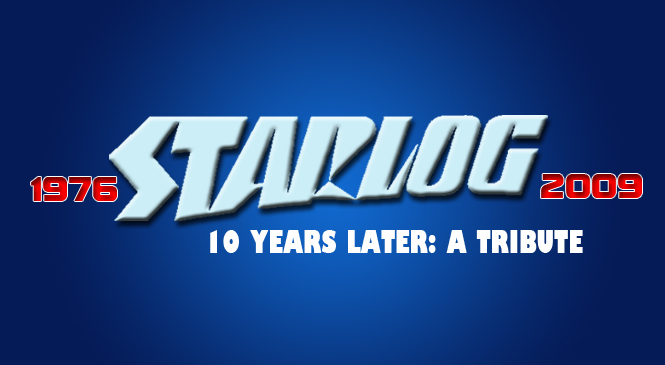Mr. Harvey’s STARLOG Memories

I honestly can’t be sure what the first issue of Starlog I saw as a child was.
I do know it was somewhere in the fall of 1977 – you know, that year where a certain film came out – and it might have been issue 9, the one with articles about the Wonder Woman and The Man From Atlantis TV series. I do know that the first issue I bought – well, OK, I was 10 at the time, so my dad bought it for me – was Number 33, with Kirk Douglas and Farrah Fawcett on the cover and a feature article about their new film Saturn 3. I’ve no idea what happened to my copy of that issue, but I do know that between a father who fed his son’s imaginative nature with his own love of science fiction, and first Starlog and later Fangoria, my imagination and wonder at the power of stories were nurtured gloriously.
It was a different time.
 Today we’re almost overwhelmed with information about the films, TV shows, books and comics that make up this wonderful genre world we love, but back then – when Star Wars was new and “You’ll Believe a Man Can Fly” was a phrase that was magical – if you wanted to know about these things, you needed Starlog. That’s where you got Harlan Ellison reviewing Star Trek: The Motion Picture (he didn’t like it), the news that the team behind the Swamp Thing movie planned to make a Batman film in the early 80’s (we wouldn’t have liked it), and how a kid in the US could order Doctor Who records and novels, if only he could bring himself to take a pair of scissors to this wonderful magazine to cut out the order form.
Today we’re almost overwhelmed with information about the films, TV shows, books and comics that make up this wonderful genre world we love, but back then – when Star Wars was new and “You’ll Believe a Man Can Fly” was a phrase that was magical – if you wanted to know about these things, you needed Starlog. That’s where you got Harlan Ellison reviewing Star Trek: The Motion Picture (he didn’t like it), the news that the team behind the Swamp Thing movie planned to make a Batman film in the early 80’s (we wouldn’t have liked it), and how a kid in the US could order Doctor Who records and novels, if only he could bring himself to take a pair of scissors to this wonderful magazine to cut out the order form.
And no, I couldn’t bring myself to do it.
But it was all there in Starlog. Reviews, science, upcoming films, convention dates, fan club applications for Jedi Knights and Time Lords, and most importantly for this growing boy, the interviews with the people who made the magic happen. Every month there was something to look forward to, every month there was something to learn, and every month there was something magical.
The Empire Strikes Back. The Shadow. Star Trek: The Next Generation. Clash of the Titans. Aliens. Timecop. The Greatest American Hero. Conan the Barbarian. Batman ’89. Freejack. Alien Nation. Total Recall. Coneheads. Clan of Cave Bear. Big Trouble in Little China. Dune. Gremlins. The Fly II. Universal Soldier. The Living Daylights. The X-Files. Tron. Quantum Leap. Knight Rider. Willow. Darkman. Robin Hood: Prince of Thieves. Highlander. Nothing But Trouble. The Puppet Masters. Heart Beeps. The Dark Crystal. Species.
That’s just a tiny fraction of the genre films and TV shows I read about in the pages of Starlog, and for all the, um – let’s call it range of quality of the finished product – the writers and editors treated each subject with respect and attention to detail. Sure, the reviews published in those pages might discuss the highs and lows of each project, but the articles about the making of those films and shows and the people behind them? Those took the reader inside, showing the effort and commitment and enthusiasm the men and women creating those genre shows brought to their work. I’ve made short films and worked on feature films, and no matter how they turned out – and not all of them did the way that any of us hoped – the process was always fun, fascinating and educational. I know that came from being primed for it in the pages of Starlog.
I never actually got a subscription to Starlog, or any other genre magazine. My only comic book subscriptions were gifts from a friend in junior high. For me, getting the latest issues involved going to comic book shops, or the couple of stores in my Kansas town that had the kind of giant magazine selections that included comics. It was almost a ritual, those trips to Prairie Dog Comics, Town Crier, or that one shop, run by a British gentleman – I think it was called Plato’s Cavern – where we could find imports like jelly babies and Doctor Who Technical Guides. They all sold Starlog, and every month there was a new adventure to be had in those pages, alongside Micronauts, Batman, X-Men and Strikeforce: Morituri.
After college, I stopped buying comics and film magazines for a time. Not for lack of interest, but because I was working for a used bookstore and a movie theatre, and my genre needs were being fed quite nicely through my work. Well, also because while both of those jobs were always fun, they weren’t the most profitable of gigs. I was still devouring science fiction, fantasy and horror content on a regular basis, but for a time, Starlog and Fangoria and the comics weren’t in the budget. When I went to work for Borders in ’95, Starlog was on the shelves there, and it was a little like coming home – OK, it was a lot like coming home, especially since I was literally working in the town I grew up in. The trips to the comic book shops resumed, and so did the monthly dive into Starlog, only ending when I moved to Kansas City in 2005.

The last issue of Starlog I ever purchased was 356, which would sadly fall victim to the not-so-tender talons of one of my cats, less than thrilled about the move. It was the June 2007 issue, and inside were articles about Spider-Man 3 and FF2: Rise of the Silver Surfer, Shrek the 3rd and Pirates of the Caribbean: At World’s End. There was a celebration of 30 Years of the Force, and 17 pages of Star Wars photographs. There were interviews with Bryce Dallas Howard and Lucy Griffiths, and news about the comic book series set in the worlds of Ray Harryhausen. It was everything Starlog had always been, including those order forms that had those cut-out dotted lines, only now for reproductions of the classic Mego Star Trek figures and back issues of Starlog itself.
And no, I didn’t cut them out, because copiers and scanners had been a thing for years, but even if they hadn’t been, I wouldn’t have.
It was Starlog.
And then it wasn’t.
The magazine industry took a serious hit in the early 2000’s, and Starlog joined the ranks of the fallen in April 2009. I had a front row seat to the pretty brutal contraction of the market in my bookstore years, and some classic genre magazines had fallen before Starlog, and others would soon follow. The internet was a thing after all, and we could all fill every second of every day with all the genre goodness we could ever hope for. But the internet isn’t all that friendly to long-form articles in the time of Twitter, and the kind of in-depth stories and interviews about movies and TV shows that made Starlog special are harder and harder to find. (The letter section was also a more polite and rational place than most internet comment sections, but that comes as no surprise, I expect.)
That’s one of the reasons this site exists. We love Starlog here. We grew up with Starlog here. We kinda want to be Starlog here. Without Starlog, I don’t think I’d be writing for SciFi4Me, or making movies of my own, or maybe even be a writer at all. So being able to see and hear the memories and stories of some of the people who brought Starlog to life this month has been, well, pretty amazing for me as a writer and a reviewer.
For that kid in ’77, it’s been, well, kind of magical.
![]()




